Children with Foot Problems – When Their Feet are Different
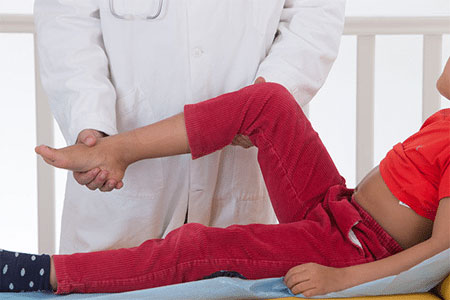
When parents find out that their children have a particular foot condition such as flat feet, rolled ankles, or low muscle tone, they tend to worry too much. I am always explaining to parents how most children’s foot conditions can be treated by wearing the correct type of shoes, and depending on the degree of your child’s foot condition, orthotics as well. Children with foot problems can strongly benefit from wearing the correct types of shoes in the correct size.
The key is to be proactive and don’t leave those foot conditions untreated, since that can lead to foot, leg, and back problems in the future.
Do you have a child that has developed a foot condition? Some of the most common foot problems among children involve:
- Flat Feet
- Overpronation
- Rolled Ankles
- Blisters
- Calluses
- Corns
Other foot conditions that are not as common involve:
- Low Muscle Tone
- Knock-Knees
- Toe Walking
- Bowlegs
While some of these problems are hereditary, some of these problems could have been prevented by wearing the correct pair of shoes.
Do you know what all of these foot conditions have in common? They are directly related to the shoes that your child wears and how they fit. I know for a fact that the correct pair of shoes can help prevent and treat any of these foot conditions.
My Experience Fitting Children’s Shoes and Orthotics
At the shoe store where I work, my coworkers and I evaluate children with foot problems daily, and based on the pain that they might be experiencing, we might recommend a pair of supportive shoes, or a pair of shoes with orthotics.
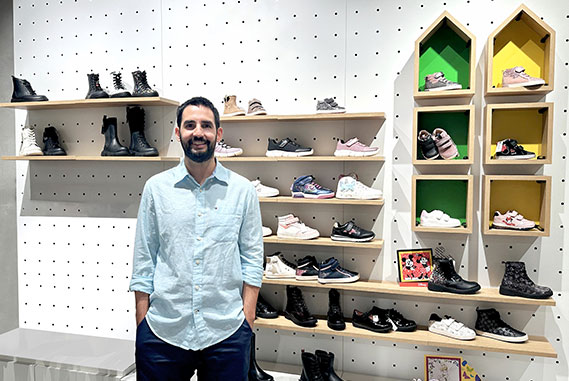
Let’s assess all these foot conditions and let me show you how the only thing that your child needs is a pair of supportive shoes and in some cases they must be accompanied by an orthotic.
Flat Feet – Overpronation – Rolled Ankles
When children overpronate, have flat feet or rolled ankles, their feet tend to turn inwards or outwards, and this throws their whole body out of alignment, which leads them to put pressure on parts of their body where they are not supposed to.
Did you know that something so simple as providing your children with the correct pair of shoes can help straighten their feet and legs and improve their overall posture?
Let me prove it to you!
Below is a picture of a flat-footed child standing barefoot. Does this picture look familiar? You might have a child at home that is also flat-footed. Do you notice how the feet are turning inwards since there is no arch to prevent the feet from collapsing?
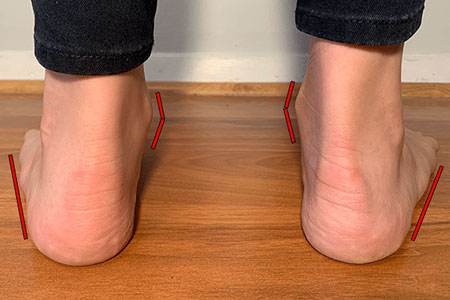
The first picture shows a child wearing a pair of unsupportive shoes made by Nike. Do you notice how the feet are still pronating and turning in?

Now let’s take a look at a picture of the same child wearing a pair of supportive shoes made by New Balance. Do you notice how the child’s feet look a lot straighter?
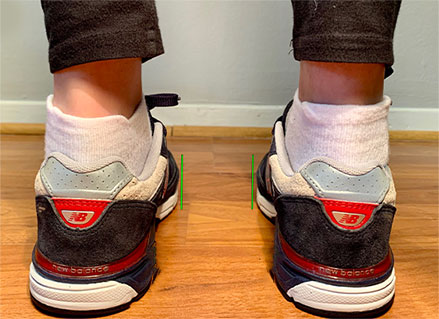
The shoes are preventing the feet from collapsing and will help the child walk and run straighter.
What Shoes Work Best for Children with Flat Feet, Overpronation, or Rolled Ankles?
If your child has any of the foot conditions mentioned above, you should take a look at a couple of different resources I created that describe the best shoes for kids with flat feet, overpronation, and ankle pain.
You might be asking yourself, why does my child have flat feet? Existing literature points towards flat-footedness being hereditary or genetic. I always ask the parents who come with a flatfooted child to the store if there is a family history of flat feet in the family. Over 90 percent of the parents always give the affirmative answer “yes”.
Blisters – Calluses – Corns
All of these foot issues are also related to the shoes that your child wears and how they fit.
Children normally develop these 3 foot issues when they are wearing shoes that are too long, too short, too narrow, or too wide.
If a shoe is too short or too narrow, your child’s toes will rub against the front or the side of the shoes, and that constant friction will lead to blisters and calluses. On the other hand, if your child’s shoes are fitted too long or too wide, this will allow your child’s feet to move too much inside the shoes and that constant rubbing will also lead to the formation of blisters.
Another reason why children develop these foot issues from not wearing socks, since socks act as a barrier between your kids’ feet and the shoes.
To prevent these foot issues you need to provide your child with the correct shoe size —this involves the correct shoe length and the correct shoe width— Make sure that your child always wears socks with his or her shoes.
I always recommend parents take their children to their local children’s shoe store that they trust, the issue is that most stores have been closing down and parents need to end up buying their kids’ shoes online. There is nothing wrong with this, but you must know your child’s exact foot size to know what size to order. I created a resource that describes the simplest, yet most effective way to figure out your child’s foot size from home.
In that article I help parents determine their child’s exact foot size and whether the child has narrow, medium, wide, or extra wide feet. I also will be able to tell you whether your child has a high instep or not.
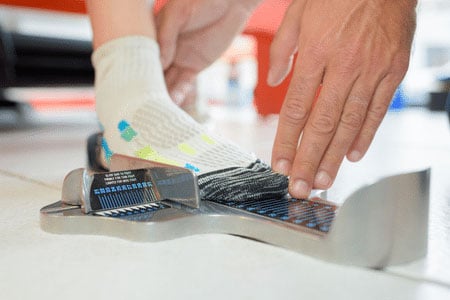
Low Muscle Tone – Knock-Knees – Toe Walking – Bow Legs
When children first learn how to walk, and you see them “toe walking”, this is somewhat normal, since they are learning how to stay up and balance. After they have learned how to walk, if they are still up on their toes, it might be a sign of muscular issues and you should ask your physical/occupational therapist or doctor how to “ground” them.
Walking all the time on their toes is not normal and may require certain shoes or even orthotics to help the child achieve a “heel to toe strike”. Firmer, stiffer shoes will help prevent it and stop them from walking on their toes.
I have fitted several children that were toe-walkers. The key is to find a stiffer shoe that is not flexible and doesn’t bend in the top as much. Less growing room in the shoe will also prevent your child from toe-walking. You also have to compromise on the length of the shoe as well, since if you leave too much growing room in the shoe this will make your child more prone to standing on his or her toes.
What Shoes Work Best for Kids with Low Muscle Tone, Toe Walking, or Knock Knees?
Here is a list of resources that describe the best shoes for toe walking, low muscle tone, and knock knees.
Orthotics for Children with Foot Problems
A pair of well-fitted orthotics with a pair of well-fitted shoes, will allow your child to walk and run straighter. Orthotics are important in realigning your child’s body posture as well as strengthening the muscles. They also might be a short-term solution to your child’s foot problems if early intervention is provided. Keep in mind that in some cases children might need orthotics for a prolonged period of time.
If your child is experiencing leg or foot pain, you must act on it as soon as possible. Pain in our kids’ feet and legs is not normal, and it must not bereft untreated. They might not just be growing pains, so always start by checking the shoes that your child is wearing.
What Are the Best Orthotics for Kids?
I have fitted several different types of orthotics throughout the years, but there is a particular one that I have found to be the most effective one in helping children walk and run straighter and reducing or fully eliminating their feet and leg pain.
These orthotics are made of extremely comfortable materials, provide arch and ankle support, and it will help align your kids’ feet and legs by preventing your child’s feet from collapsing when walking or running —as long as it’s fitted in the correct pair of shoes.
These are the 4 most important features that these orthotics provide:
1️⃣ Footlogics orthotics are crafted from premium medical grade PU foam for children with heel and arch support problems.
2️⃣ The orthotic is designed to mold over time to fit each child’s unique foot.
3️⃣ The orthotic is made of premium medical grade PU foam for kids with heel and arch support problems.
4️⃣ The orthotic is also made of a new soft step material that drastically increases comfort.
Fits Toddler Shoe Size 5 up to Big Kid Shoe Size 3
- Fits a toddler shoe size 5 up to a big kid shoe size 3
- Medically approved insoles with targeted cushion and support
- Deep heel cup with strong arch support
- Made from lightweight yet supportive cushioning material with shock-absorbing heel and forefoot padding
- They can be trimmed to size with scissors if needed
The main advantage of these orthotics is that they are easy to fit in shoes, the only thing you need to do is to remove the original insoles of the shoes that your child is wearing, and then insert the orthotic inside the shoe. If the orthotic is too big, trimmed it so it matches the length of the original insoles of the shoes.
Here you can find a great resource that describes a list of good supportive shoes to accommodate the orthotics that I recommended.
Now that you know which are the best shoes and orthotics for children with foot problems, you are ready to make the most informed decision.
Is your child experiencing leg or foot pain? Certainly, contact me via e-mail: [email protected] or in the comments section with further questions that I will most likely be able to answer.




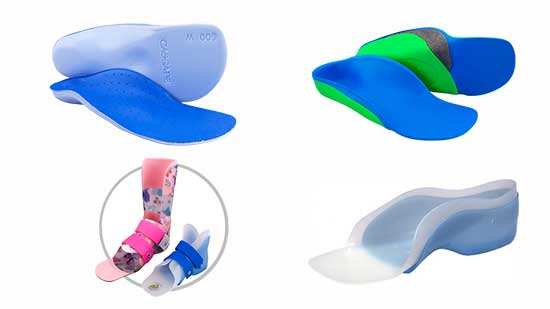
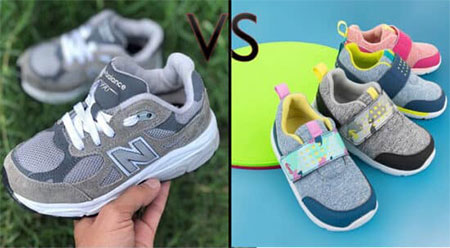
Hi Juan! My daughter is 4 and has been a toe walker since she started walking. We had her evaluated by Early Childhood Intervention at 2. They showed no concern, said she would grow out of it and just liked the bounce it gave her. Now, at 4, she has started PT with the possibility of needing casts after 3 months because she can’t flex foot past 90 degrees. I am having a hard time finding specific brand/shoe that will make it harder for her to go up on her tip toes. I’ve asked her PT and have not received a response. Your help would be much appreciated!
Hello Ashley,
First of all look for shoes that are not flexible and try shoes that come with shoelaces instead of velcro. There is a particular shoe style that I have fitted before that might help ” ground her feet”. The shoe style is called ” KJ888V2″ and you can find a link to that shoe style here:
The Best Shoes for Toe Walkers
If that shoe style doesn’t help ground her I will try an orthotic before trying a cast. Orthotics make a huge difference, at least with the children we have helped at our store. Ask your PT and make sure you get the correct shoe size for your daughter! Please don’t leave too much growing room, the less growing room the better since it will prevent her from going on her toes.If you leave too much growing she will most likely go on her toes. I hope this helps!
Wow. I learned a lot about pediatr It’s clear you know what you’re talking about!ic orthotics! Excellent article.
Jim,
I am glad you found the post informative.
Hello Juan,
Very good & informative article, i am waiting for a baby next month & i am always searching about things related to babies care,health,food Etc, really this post gives me a lot of information about orthotics which i don’t know anything about before, thanks for the post.
Ehab
Wow, what thorough research! I noticed my daughter walking on her toes quite a bit, so I will keep an eye on her and see if it changes in the near future! Thanks so much for posting this! What other measures could I take to prevent any unhealthy walking habits from emerging?
Kylie,
How old is your daughter? Once I know her age I will be in a position to provide you with a better answer. In order to prevent unhealthy walking habits you must provide your daughter with the correct pair of shoes, and in order to do this she needs to have her feet measured by a shoe fitter.
Wow! Super informative! My cousin was recently telling me how he was always leaning his feet outwards, and balancing on the side of his feet, and he said he never realized how terrible it was for his feet and legs in general, until he started to run for exercise. Now he says he feels more aligned and the pain has diminished! Too bad his parents didn’t know this much sooner! Thanks for the knowledgeable read! =)
Kylie,
I am glad his pain went away. Thank you for stopping by.
Hi Juan, this is really informative and helpful article to me. It is the first time I read about orthotics. I have 2 year baby and it will definitely help me to care my baby to keep out the foot problems.
Thanks for this article.
Santosh,
Hopefully the article provide you with information on what to be in the lookout when it comes to foot problems.
Hi Elvalen
This is an excellent resource for parents with children who have ‘problem’ feet. Well done! You are so knowledgeable and caring! My eldest daughter has very flat feet and we always had trouble getting shoes to fit her. She has problems as an adult, probably because we didn’t know enough about these orthotics and other devices to help her. I will be sure to pass this website on to any parents I meet who have trouble with their kids’ feet. I can see it is so important for ALL children to have correctly fitted shoes and unfortunately, with the thousands of ‘cheap’ shoes available, people don’t take enough care to buy good quality shoes.
Thankyou for creating this website!
Ellie
Ellie,
I do enjoy working with children and I understand the importance of proper shoe fitting. I have been fitting children shoes for only five years, but the store I work for is extremely busy and I do see hundreds of children each week. I disagree with one thing, not all cheap shoes are bad for children.There are certain styles very reasonable priced that have a lot of support, but you are right about the fact that most of them do not offer enough support.
Hi Juan,
Very informative article. I was wondering how young is too young to start looking at whether or not your child is flat-footed? My son is coming up on a year and his feet are still really flat and they are pronated. He doesn’t wear shoes often and I see his little ankles always “caving in” when he stands. Is that normal? What age would something like that go away if it’s not a long-term problem?
Thanks,
Lori
Lori,
You should consult with a physical therapist to have his feet evaluated. Some of the flatfooted children only require correct supportive shoes, but several of them need orthotics reinforcement. If he is flat footed that is an issue that will not go away. His feet can be given relief by the use of orthotics and other means, but no remedy or cure. However, early intervention is key to avoid future problems. There is a lot of controversy revolving around what age a child should start wearing orthotics. I believe that if they have low tone issues they should start wearing orthotics as early as when they start walking. If he is flat footed and his ankles are “caving in” you should consult your physical therapist as soon as possible.Please follow up and let me know what your PT says.